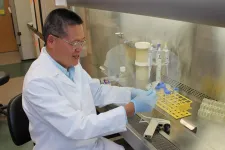(Press-News.org) Environmental quality is associated with advanced-stage prostate cancer at diagnosis, according to a new study by University of Illinois Chicago researchers.
Prostate cancer is up to 57% heritable, with the remainder attributed to environmental exposures. However, studies on those environmental factors and prostate cancer aggressiveness have previously been limited. For their study, "Association between environmental quality and prostate cancer at diagnosis," published in the journal Prostate Cancer and Prostatic Disease, researchers paired data from the environmental quality index, or EQI, and the Surveillance, Epidemiology and End Results Program, or SEER.
Study co-author Dr. Michael Abern, associate professor and director of urologic oncology at University of Illinois College of Medicine, said by combining the data from SEER and EQI, researchers found that lower environmental quality was associated with advanced-stage prostate cancer diagnosis.
The EQI combines data from multiple sources and reports an overall quality index, as well as five subdomains: air, water, land, built and sociodemographic. The data is collected from sources such as Environmental Protection Agency air quality monitoring.
"When we drilled down further into the subdomains of the EQI, we found that some of the associations were stronger than others. Specifically, the land, water and sociodemographic domains seem to be driving the association more than air or built domains," Abern said.
Additionally, areas with low-quality land, water and sociodemographic variables showed the strongest association with prostate cancer being diagnosed at a later stage, which can mean poorer treatment outcomes.
The study also found that race was an independent predictor of metastatic prostate cancer -- cancer that has spread -- at diagnosis, with Black men at higher risk. That risk is elevated more when coupled with living in an area with low environmental quality.
According to the study, there were more than 174,000 newly diagnosed prostate cancer cases and more than 31,000 prostate cancer deaths in the United States in 2019, making it the most common non-cutaneous (skin) malignancy in men. When diagnosed early, prostate cancer has a nearly 100% five-year survival rate.
Though there have been other studies that explore environmental exposures, they often compare a single agent and individual exposure. Using the EQI and SEER offers a more comprehensive ecologic analysis to better represent environmental exposures and the relationship to advanced prostate cancer, the study states. Because the EQI also looks at sociodemographic variables, it takes health equity into account.
"They are actually measuring infrastructure and barriers to getting healthcare," Abern said.
Abern said the study provides the ability to make hypotheses as to why late-state prostate cancer diagnoses are higher in certain areas, and then drill down into the components of the environmental variables to try to find solutions such as environmental policy changes.
It is well established that age and Black race are risk factors to develop prostate cancer in addition to genetic risk factors including family history. An important distinction can be drawn between incidence and aggressiveness, Abern said, and this study focuses on the aggressiveness of prostate cancer.
"When I see a patient with prostate cancer, they assume maybe they got it because of something they did. It is probably not. Not a lot is known about personal lifestyle choices that lead to prostate cancer. Diet, exercise and smoking have never had a very strong association with prostate cancer," Abern said. "Seeing a doctor and getting screened is still the most important thing about getting diagnosed."
INFORMATION:
In addition to Abern, the authors are Dr. Hari Vigneswaran, Jyotsna Jagai, Dr. David Greenwald, Megh Kumar, Dr. Ryan Dobbs and Dr. Daniel Moreira, all of UIC; and Achal Patel of the University of North Carolina.
Around the world and within the U.S., the percentage of people wearing masks during the Covid-19 pandemic has varied enormously. What explains this? A new study co-authored by an MIT faculty member finds that a public sense of "collectivism" clearly predicts mask usage, adding a cultural and psychological perspective to the issue.
The study uses a series of datasets about mask usage and public attitudes, along with well-established empirical indices of collectivism, to evaluate the impact of those cultural differences on this element of the pandemic response. ...
Flies predict changes in their visual environment in order to execute evasive maneuvers, according to new research from the University of Chicago. This reliance on predictive information to guide behavior suggests that prediction may be a general feature of animal nervous systems in supporting quick behavioral changes. The study was published on May 20 in PLOS Computational Biology.
Animals use their sensory nervous systems to take in information about their environments and then carry out certain behaviors in response to what they detect. However, the nervous system takes time ...
The immune system is a complex balancing act; if it overreacts or underreacts to foreign molecules, there can be serious health consequences.
For cancer patients, tumor progression is often accompanied by immunosuppression, meaning their bodies can't fight off pathogens the way they should. By contrast, for people with autoimmune diseases like type 1 diabetes, rheumatoid arthritis, and multiple sclerosis, their immune systems overreact and attack the body itself.
Both of these reactions are influenced by a series of molecular checkpoints found in both immune cells and cancer cells. In immune ...
Oysters live and grow in saltwater. However, the saltiness of their habitat can change dramatically, especially where the mighty Mississippi River flows into the Gulf of Mexico. Louisiana oysters from the northern Gulf of Mexico may experience some of the lowest salinity in the world due to the influx of fresh water from the Mississippi River. In addition, increased rainfall and large-scale river diversions for coastal protection will bring more fresh water that does not bode well for the eastern oyster. New research led by Louisiana State University (LSU) alumna Joanna Griffiths from Portland, Oregon, and her faculty advisor ...
ROCHESTER, Minn. -- You might be older - or younger - than you think. A new study found that differences between a person's age in years and his or her biological age, as predicted by an artificial intelligence (AI)-enabled EKG, can provide measurable insights into health and longevity.
The AI model accurately predicted the age of most subjects, with a mean age gap of 0.88 years between EKG age and actual age. However, a number of subjects had a gap that was much larger, either seemingly much older or much younger by EKG age.
The likelihood to die during follow-up was much ...
During the pandemic, the old waiting room phrase "the doctor will see you now" has taken on a new meaning. So has the waiting room. Our kitchen table or living room couch is where many people do work lately, and that includes visits to the doctor. New research from Syracuse University's Falk College indicates this method of health care will continue even after COVID numbers are (hopefully) reduced.
"I was surprised by the results," said the study's lead author Bhavneet Walia, assistant professor of public health at Syracuse University. "I initially thought that, because of the challenges of telehealth, physicians would not be in favor of continuing post-pandemic. It turns out they do. But ...
Researchers have long been interested in finding ways to use simple hydrocarbons, chemicals made of a small number of carbon and hydrogen atoms, to create value-added chemicals, ones used in fuels, plastics, and other complex materials. Methane, a major component of natural gas, is one such chemical that scientists would like to find to ways to use more effectively, since there is currently no environmentally friendly and large-scale way to utilize this potent greenhouse gas.
A new paper in Science provides an updated understanding of how to add functional groups onto simple hydrocarbons like methane. Conducted by graduate students Qiaomu Yang and Yusen Qiao, postdoc Yu Heng Wang, and led by professors Patrick J. Walsh and Eric J. Schelter, this new and highly detailed mechanism ...
HOUSTON - (May 20, 2021) - It's always good when your hard work reflects well on you.
With the discovery of the giant polarization rotation of light, that is literally so.
The ultrathin, highly aligned carbon nanotube films first made by Rice University physicist Junichiro Kono and his students a few years ago turned out to have a surprising phenomenon waiting within: an ability to make highly capable terahertz polarization rotation possible.
This rotation doesn't mean the films are spinning. It does mean that polarized light from a laser or other source can now be manipulated in ways that were previously out of reach, making it completely visible or completely opaque with a device that's extremely ...
At the start of the COVID-19 outbreak, a University of Illinois Chicago researcher conducted a survey asking respondents if they experienced health care delays because of the pandemic. In addition to learning about the types of delays, the study also presented a unique opportunity to capture a historic moment at the pandemic's beginning.
Elizabeth Papautsky, UIC assistant professor of biomedical and health information sciences, is first author on "Characterizing Healthcare Delays and Interruptions in the U.S. During the COVID-19 Pandemic Using Data from an Internet-Based Cross-Sectional ...
During the first phase of the COVID-19 epidemic, New York City experienced high prevalence compared to other U.S. cities, yet little is known about the circulation of SARS-CoV-2 within and among its boroughs. A study published in PLOS Pathogens by Simon Dellicour at Université Libre de Bruxelles, Belgium, Ralf Duerr and Adriana Heguy at New York University, USA, and colleagues describe the dispersal dynamics of COVID-19 viral lineages at the state and city levels, illustrating the relatively important role of the borough of Queens as a SARS-CoV-2 transmission hub.
To better understand how the virus dispersed throughout New York ...





